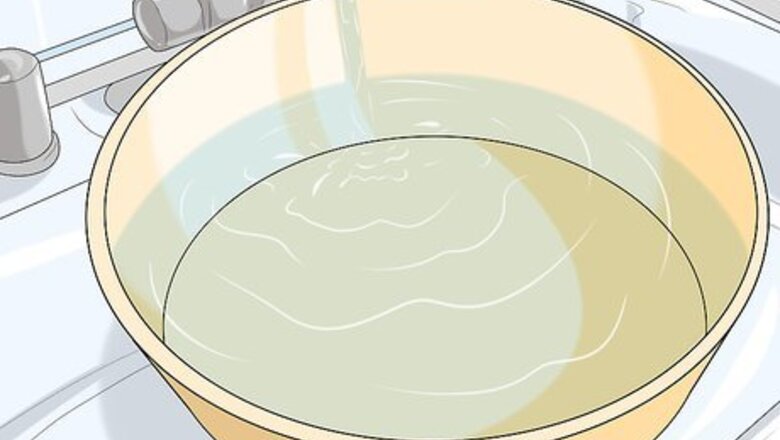
views
Washing an Acrylic Sweater by Hand

Fill a spacious container with cold or lukewarm water. Acrylic is prized for its water, stain, and wrinkle-resistant properties. However, it is possible for the fabric to stretch or even melt when exposed to high temperatures. For this reason, it’s always best to wash sweaters and other acrylic clothing items using cool water. Your kitchen or bathroom sink should offer more than enough room to hand-wash a single sweater. If you don’t have a suitably-sized sink available, you could also run a few inches of water into your bathtub, or hunt for a clean plastic storage container or bucket.

Mix a small amount of mild liquid detergent into your washing water. A good rule of thumb is to use no more than about 1–2 tablespoons (15–30 mL) of detergent for every 1 gallon (3.8 L) of water. Whisk the soap into the water by hand to make sure that it’s evenly dispersed. It’s alright to use liquid laundry detergent, provided it’s a gentle variety that’s safe to use on delicates. Liquid soaps or shampoos made from all-natural ingredients can also do the job if you don’t have anything else on hand. You don’t want to get the water too soapy, as this could make it hard to rinse all of the suds out of your sweater later on.
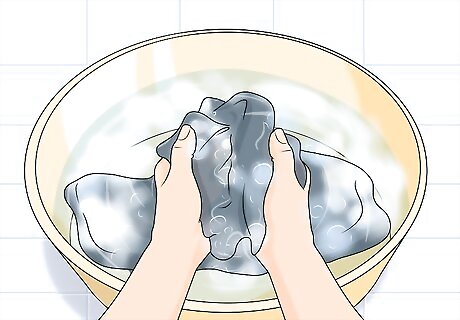
Swish the sweater back and forth through the soapy water. Lower the garment into your wash container and begin plunging and squeezing it repeatedly. Acrylic fibers are smooth, and don’t hold onto foreign substances very tightly. The gentle agitation created by the water flowing through the fabric should be enough to loosen most dirt and stains. If you encounter any stubborn spots, try rubbing them lightly with the pad of your finger to provide a little extra friction.Warning: Avoid scrubbing, twisting, or wringing the sweater. This could easily damage the delicate woven fabric.
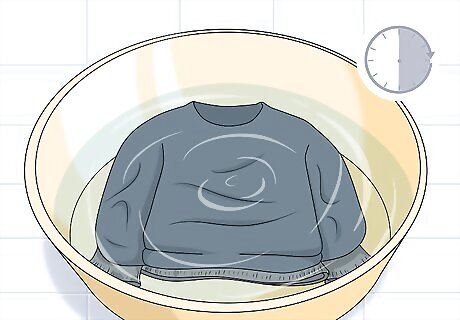
Soak your sweater for up to 30 minutes if it's especially dirty. When dealing with a heavily-soiled garment, it’s okay to let it soak for a while. This will give the water more time to act on the dried mess, eventually weakening its grip. Just set a timer to alert you when it needs to come out and move on to the next item on your to-do list. Come back periodically and swish the sweater through the soap solution to release as much clinging dirt and debris as possible. If a long-set stain doesn’t come out after about half an hour, it may be beyond your ability to clean at home without harming the garment. Consider taking it somewhere to have it cleaned professionally.

Rinse the sweater thoroughly with clean, cold water. Once you’re satisfied with the cleanliness of your sweater, remove it from your wash container and drain the dirty water. Hold the garment under a running faucet until every last bit of soapy solution has been flushed out of the fabric. Turn the sweater slowly under the tap to ensure that the water makes contact with each part of it.
Machine-Washing an Acrylic Sweater
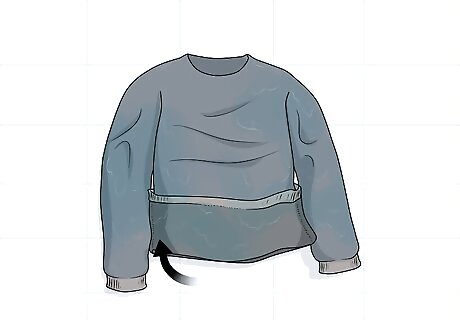
Turn the sweater inside-out to minimize pilling. “Pilling” occurs when loose threads become tangled up and form little balls, giving clothing a worn, unkempt look. By turning your sweater inside-out, you can make sure that any pilling that takes place does so on the side that no one will see. If pills do happen to form on the outside of the sweater, getting rid of them is as simple as giving them a few light swipes with a disposable razor. Larger knots can be snipped off with a pair of scissors. It’s also possible to buy handheld de-pilling devices designed to shave off pills safely and easily. One of these could come in handy if pilling is a frequent issue when washing knit and woven items.

Set your washing machine to its gentlest wash cycle. Acrylic retains its shape better than most synthetic fabrics, but it’s still vulnerable to stretching out when handled roughly. If your machine has a “Delicates” or “Hand Wash” setting, it will be your best bet. Other, more forceful wash cycles could leave your favorite sweater looking battered and misshapen.

Choose the lowest possible wash temperature. Cold or cool water will get your sweater nice and clean without distressing the individual fibers the way warm water might. It will also save you a little bit of money on your next utility bill, making it a win-win situation. Be sure to check the tag on your sweater before you throw it in the washer. Some acrylic garments are safe to wash in warm water, while others aren’t.

Add a small amount of liquid laundry detergent. Somewhere between 1 teaspoon (4.9 mL) and 1 tablespoon (15 mL) should be plenty for a small or medium-sized load. Generally, the old adage “less is more” rings true when it comes to washing sweaters and other delicates. The exact amount of detergent you use will depend on how much water there is in the washing machine and whether or not you’re laundering other items along with your sweater. Using too much detergent could lead to premature deterioration or buildup, which can leave clothes feeling greasy and trap bacteria inside the nooks and crannies of textured garments like sweaters.

Consider removing the sweater prior to the spin cycle to reduce wear. The rapid spinning action of the drum can wreak havoc on loose-knit garments. When washing an old or fragile sweater, it may be a good idea to hit the stop button after the rinse cycle has ended. Otherwise, there’s a chance that it could come out looking like a fancy fishing net. Many newer washing machines have “Low Spin” and “No Spin” options that make it easier to preserve delicate clothing items. If your machine has one of these options, be sure to select it. Whenever possible, it’s always better to hand-wash garments that are at risk of being damaged in the washing machine.Tip: Investing in an inexpensive mesh laundry bag can also help protect your sweaters from tumultuous machine washes.
Drying Your Sweater
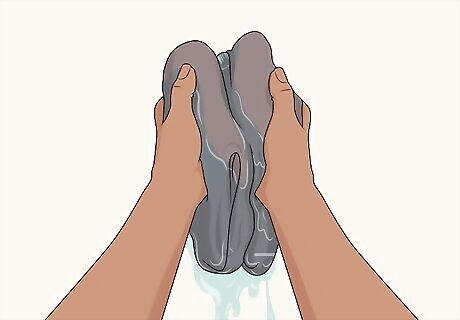
Press the excess water out of sweaters you’ve washed by hand. After removing the sweater from your wash container, wad it up loosely and squeeze it between your palms to coax out any lingering liquid. As you do, be mindful of the pressure you’re applying. You don’t need to extract every last drop—just make sure it isn’t completely saturated. You may also need to give your sweater a good squeeze if you opted to take it out of the washer before the spin cycle. There should be no need to press sweaters that have been through a full wash cycle. Never wring, twist, or ball up a sweater. Mangling it in this way could cause it to lose its shape permanently.
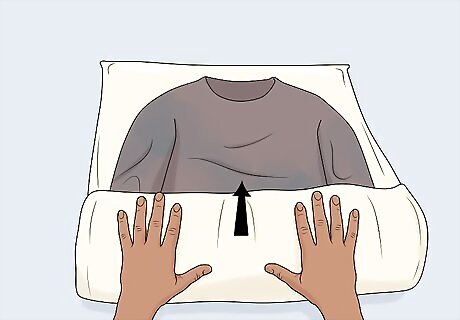
Roll the sweater tightly in a towel to remove even more moisture. Stretch a clean, dry bath towel out on the floor and lay the sweater on top. Then, starting at one end, roll the towel up with the sweater inside and leave it bundled for 5-10 minutes. The towel will absorb whatever moisture escapes while it sits. Towels made from ultra-soft materials like microfiber or terry cloth are less likely to rough up your sweater while they’re pressed together.
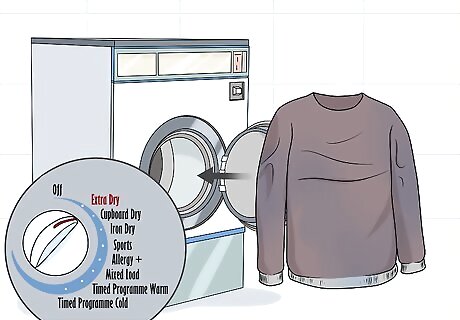
Tumble dry your sweater on low heat if it’s safe to do so. Some sweaters, especially those made from a blend of natural and synthetic fabrics, can be machine-dried without fear. If the sweater you're washing is dryer safe, it should say so on the tag. Just be sure to put it in by itself and set your dryer to low or no heat to decrease its chances of stretching. Check on your sweater frequently and take it out of the dryer as soon as it feels dry to the touch. If you dry your sweater in a full machine, it could get tangled up with other items, which can also contribute to stretching and wrinkling.
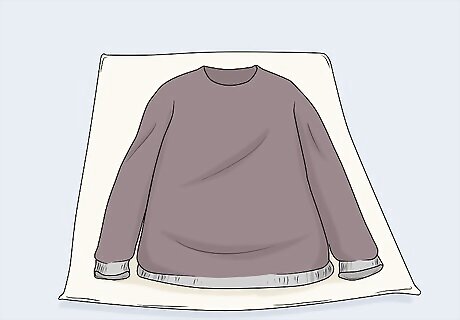
Lay out the sweater in its natural shape on a fresh towel or drying rack. Arrange the garment so that the sleeves are fully extended and completely free or folds, wrinkles, or creases. That way, you can guarantee that it will end up looking the way it’s supposed to once it’s no longer damp. Drape a towel over your drying rack to continue soaking up moisture and help your sweater dry even faster. It’s not a good idea to hang a freshly-washed sweater, due to all the extra weight.
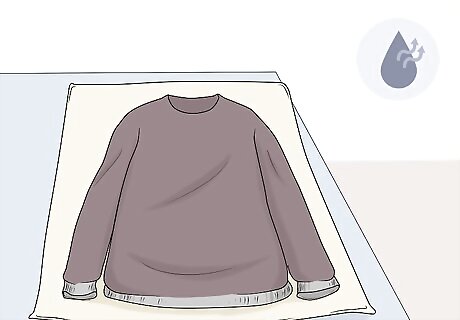
Allow the sweater to air-dry completely before wearing it again. All that’s left to do now is wait for the remaining moisture to evaporate. This shouldn’t take more than a few hours, as acrylic is a fast-drying synthetic fabric. In no time flat, your sweater will be ready to slip on for your next outdoor jaunt or casual get-together. If you dry clean a sweater and the fabric contracts a little, you can steam it. If there are stains, wet clean the sweater. Wash and dry it at low heat. Take it out when it is slightly damp to prevent it from shrinking. Don’t put your sweater back on until it’s had time to dry completely. Stretching out the fibers while they're still damp is practically guaranteed to leave it looking loose, limp, and lifeless. If you're not planning on wearing your sweater right away, fold it neatly and put it away in a drawer. It's best to avoid hanging knit sweaters, even when they're dry. Gravity is another common cause of premature stretching.Tip: In a hurry to rock your favorite sweater? Speed up the drying process a bit by situating it near a fan, open window, or dehumidifier.




















Comments
0 comment